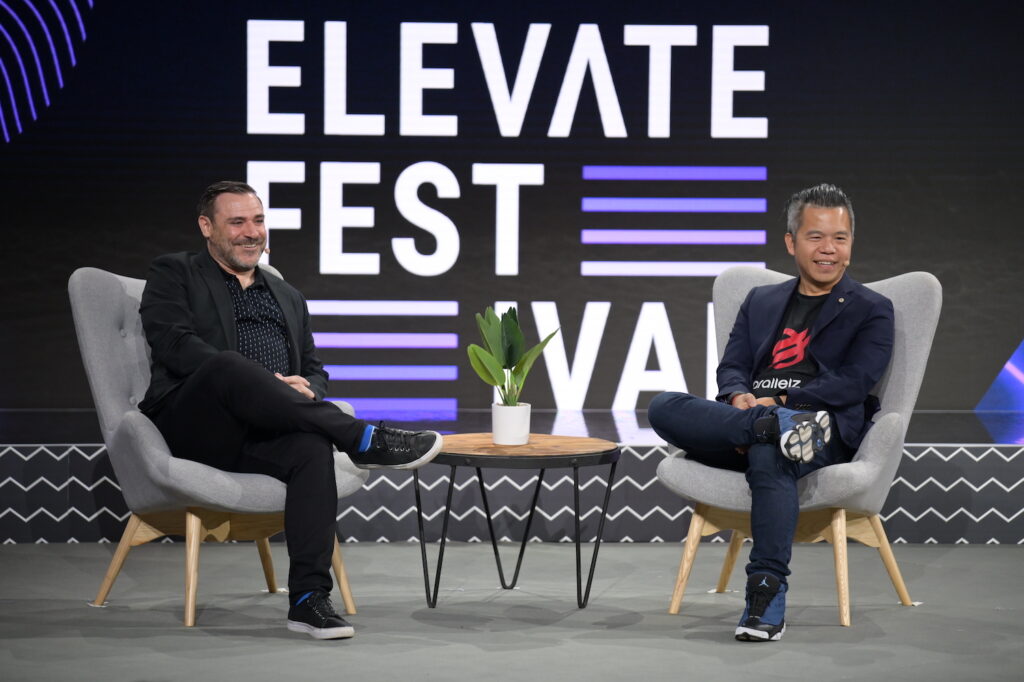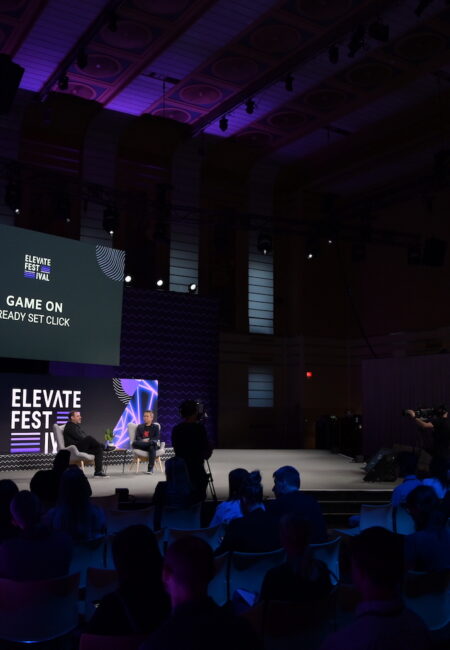By: Elevate Content Team, November 30 2022
From draw-based lotteries to mobile gaming, the world of gaming is changing rapidly. It’s unlikely the gaming companies of tomorrow will look like the gaming companies of today. On Elevate Festival’s Game On Stage, presented by OLG, Dave Pridmore, OLG’s Chief Digital & Strategy Officer, was joined by Albert Lai, Founder & CEO of Big Viking Games to share key insights from the gaming space.

With multiple lines of business, including lotteries, land-based gaming, casinos, charitable gaming halls, and its digital offering, OLG interacts with about four million customers a week across all of their business lines. Like many organizations transforming their business in the digital space, expressing their competitive advantage and staying competitive in this environment are top of mind. With this in mind, these experts shared how to stand out in the hyper-competitive gaming market in 3 ways and keep up with the top 10 online gaming trends.
Define a digital strategy that aligns with your competitive advantage.
By exploring ways that the business will converge with digital in the future, many businesses can visualize what steps they need to take to lean into their competitive advantage. The digital gaming environment is highly competitive, one where OLG has been starting to spend a lot of its time, says Pridmore. As behaviours change, their organization has been adapting its business model to match. Their competitive advantage has been their Ontario-first focus from the get-go. With all of their proceeds going back to Ontario, it only makes sense for them to leverage this every day, especially in the digital environment, to make sure they are staying competitive.
Leverage partnerships for innovation and new customer acquisition.
With the many challenges that come with being competitive in the gaming market, the questions that keep these leaders up at night are how to ensure customers keep their brands top of mind for their customers in the gaming space and especially in the App Store. Being a market leader isn’t an easy feat. However, if your company can develop partnerships with organizations that are, in fact, leading innovation in the space where you want to be more competitive, then you’re taking a step in the right direction.
“A critical function of us thinking about competing in this market is thinking about working with companies like Albert’s to really springboard our innovation by really piggybacking off of some of the great work they are doing with Parallelz and, obviously, Big Viking Games. So that’s what keeps us up at night, but also is really exciting as we think about the future of our partnerships and the things that we can do together,” says Pridmore.
When it comes to finding new customers, especially in the eSports gaming space, Pridmore explains, partnering with a company like Overactive Media, can get companies closer to a different customer base. While OLG has its core customers, it has to continue to think about attracting new customer demographics in different ways.
“How do we put OLG’s brand in different places that you wouldn’t normally think of us as being in? We try a lot of new and exciting things with working with a clothing designer to working with ice cream bars, as well, to try to create an attraction with a younger demographic… [OLG is] wondering how we can work with others to really capitalize on those trends as we go forward,” Pridmore reveals.
Use technology to stay ahead of the curve.
There are many ways a business can stay sharp, innovative, and ahead of the competition. This all depends on the tools, platforms, and systems it chooses to invest in and leverage. By leveraging Parallelz, a platform technology they have been developing for over a decade, Big Viking Games was able to carve a new competitive path for itself in this space.
“[Parallelz allows you] to basically take a native application without changing any of the underlying code, any SDKs that need to be added, no additional work, basically, to deliver that same application, and transform it into a native web application that allows a user to, with one click, be able to access it instantly, without any of the 30% tax or having to deal with any of the challenges around the terms of service or the restrictions and friction of the App Store,” says Lai, the founder and CEO of the social and mobile gaming company, one of OLG’s trusted partners.
The Top 10 Online Gaming Trends to Watch Out For
- The race to the bottom.
In the online gaming world, while competitors are trying to outspend one another for customer acquisition, OLG is taking it in a different direction by thinking about how they can be more focused on a regional-first approach in Ontario. By doubling down on the company’s specific geographic or strategic advantage, it’s possible for companies to go upstream in this market.
- Free-to-play & social gaming.
One of the leading gaming trends of late has been free-to-play games and social gaming. Companies need to ask themselves how they can create a different environment than the very traditional gaming by bringing in sports betting and integrating different customer experiences into the digital gaming platform.

- Underlying tech that evolves at the same level of products.
A few considerations need to be addressed when ensuring that the innovative products an online gaming company plans to roll out need to be supported by the underlying tech stack. Not only does the technology need to be frictionless for the customer, a strong presence in the App Store, the ability to quickly onboard customers and rapidly respond to their needs are all part of the journey to innovation in this space.
- Consolidation of power and distribution as a challenge for traditional customer acquisition.
Lai weighs in by tracing the historical pressure that big tech companies like Apple and Google have put on online gaming companies through the consolidation of ad networks and what he calls the “App Store tax,” whereby Apple takes a 30% cut of revenues. Big tech is also consolidating by becoming publishers on desktop with their own portals or their own desktop distribution system.
- Influencers as distributors and able to generate awareness.
With the potential for higher ROI opportunities for distribution and generating awareness in the eSports space, influencers will rise to meet gaming companies in this new environment, says Lai.
- Non-traditional customer acquisition channels.
More channels will offer interesting distribution opportunities. With social media leading the charge in customer acquisition, new channels like Snap and Facebook have developed their individual gaming channels via the messenger platforms. Lai also sees TikTok moving into the social gaming space with the development of platforms for games within their ecosystem. I think there is going to be emerging non-traditional customer acquisition channels,
- Rising customer acquisition costs.
With the emergence of non-traditional, unregulated customer acquisition channels, there will be a continued rise in customer marketing costs, which will be the number one challenge when trying to reach our audiences, says Lai.
- Skill-based gaming as a mainstream category.
When it comes to skill-based games, Lai believes that this is a relatively underserved market that recently went public through his company’s back offering. This is a model to think about when monetizing, he says, especially if you’re looking at ways in which you can carve out a niche in the online gaming space, similar to the way in which OLG is able to balance skill-based gaming and games of chance.
- Reliance on AI and machine learning.
As AI is more widely adapted across industries, if you haven’t adopted machine learning in some serious way in the DNA of a company, warns Lai, you’re going to be at a distinct disadvantage.
“It’s going to be like basically running a game’s company without analytics. You’ll basically be dead in the water and the earlier you adopt and start implementing AI and machine learning capabilities, weaving it in wherever it makes sense in your offering, then I think you have a distinctive advantage over those that don’t,” says Lai.
Lai also stresses the use of AI and machine learning at inception, leveraging it in marketing through concept art and even in the production of games.
- Personalization as a differentiator.
Data can be leveraged for personalization, which can be used as a competitive advantage for eSports and online gaming companies. Through the creation of game recommenders, similar to a Netflix model, say Pridmore, OLG is able to grow its competitive advantage by curating libraries for individuals with data at the core. Looking into the crystal ball, Pridmore projects that OLG will find ways to intersect its lotteries, land-based gaming and casinos with its digital offering through a deep understanding of customer patterns and data across all of them, bringing them together in a way that really adds a lot of value for OLG.
Watch the Game On! Standing Out In A Hyper-Competitive Market talk, featuring Dave Pridmore, Chief Digital & Strategy Officer at OLG:
[Video to be embedded: https://vimeo.com/elevatetoronto/k2-game-on]


